Washington: US President Joe Biden and Prime Minister Narendra Modi on Saturday hailed a watershed arrangement to establish a new semiconductor fabrication plant focused on advanced sensing, communication, and power electronics for national security, next-generation telecommunications, and green energy applications. The plant will be built with support from Bharat Semi, 3rdiTech and the US Space Force.
The 'Joint Fact Sheet: The United States and India Continue to Expand Comprehensive and Global Strategic Partnership' released by the White House after a meeting between PM Modi and the US President noted the launch of a new US-India Advanced Materials R&D Forum to expand collaboration between American and Indian universities, national laboratories, and private sector researchers.
The leaders of both countries also highlighted additional cooperation being built across artificial intelligence (AI), quantum, and other critical technology areas. They praised combined efforts to facilitate resilient, secure, and sustainable semiconductor supply chains including through GlobalFoundries' (GF) creation of the GF Kolkata Power Center in Kolkata, India that will enhance mutually beneficial linkages in research and development in chip manufacturing and enable game-changing advances for zero and low emission as well as connected vehicles, internet of things devices, AI, and data centres.
What is so special about the semiconductor fabrication plant?
- This is the first-ever semiconductor fabrication cooperation of its kind, according to an official statement. It is also the first time that the US military has agreed to do a technology partnership for these highly valued technologies with India. It’s a watershed moment as powerful as the civil nuclear deal struck between India and the US in 2008.
- The Bharat Semi plant will focus on three essential pillars for modern warfighting - advanced sensing, advanced communications and high-voltage power electronics. It is not only India’s first, but one of the world’s first multi-material fab for national security. The three key areas also have huge growing needs for commercial sectors such as Railways, telecom infrastructure, data centres and green energy.
- Infrared, Galium Nitride and Silicon Carbide are the three main technology areas in this initiative. It’s part of PM Modi's vision for India to become a chip maker from a chip taker. It is also a vital component in furthering India's goal of becoming a net security provider in the region.
- This is the first true India-US semiconductor fabrication project. Other projects in the past have included testing and assembly of OSAT. India will join a handful of elite nations with the capability and know-how to manufacture these types of semiconductors on shore.
- As India and the US grapple with a common adversary - China - this project will utilise young engineering manpower and a stable supply chain to bolster national security. The cooperation with 3rdiTech and the US Space Force was first announced during PM Modi's state visit in June last year. Further details were announced during the iCET review in June 2024 in New Delhi.
Other initiatives between India and US
Biden and Modi also celebrated the new strategic partnership between the US Department of State and the India Semiconductor Mission, Ministry of Electronics and Information Technology in connection with the International Technology Security and Innovation (ITSI) Fund.
India’s current import bill for these semiconductors for national security alone is $1 Billion a year. India and the US have also signed multiple cooperations focused on critical tech with a special focus on Semiconductors -from iCET to Commerce to commerce MOU to the strategic trade dialogue. PM Modi and President Biden also welcomed efforts to enhance collaboration between the research and development ecosystems of the two countries.
The Leaders welcomed progress toward the first joint effort by NASA and ISRO to conduct scientific research onboard the International Space Station in 2025. They appreciated the initiatives and exchange of ideas under the Civil Space Joint Working Group and expressed hope that its next meeting in early 2025 will open additional avenues of cooperation. "They pledged to pursue opportunities to deepen joint innovation and strategic collaborations, including by exploring new platforms in civil and commercial space domains," it said.
ALSO READ | 'Jab dil ke darwaze khul jaate hain, to...': PM Modi to outgoing President Biden in emotional farewell speech
Latest World News
